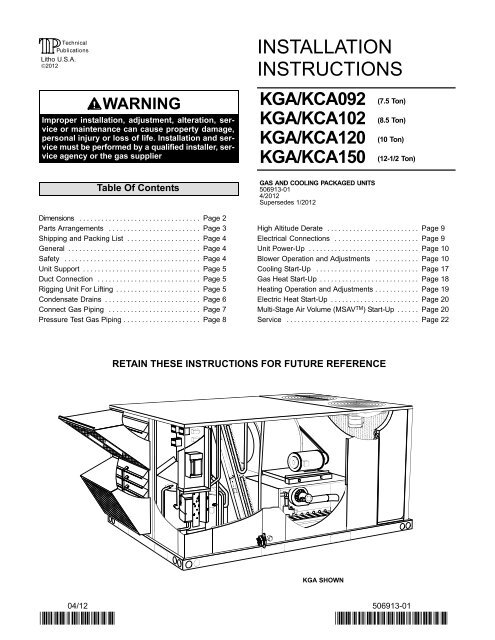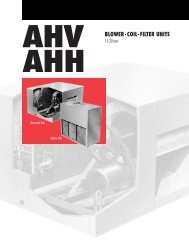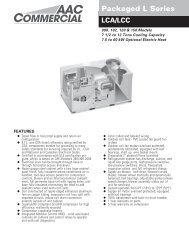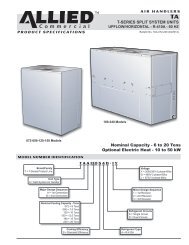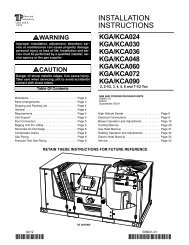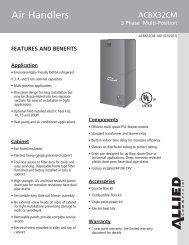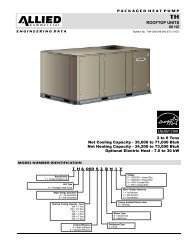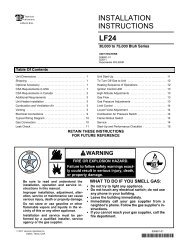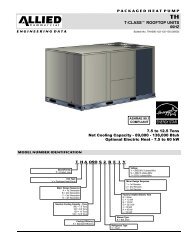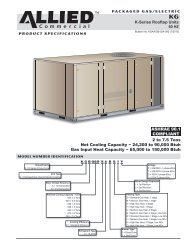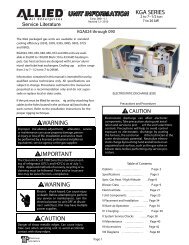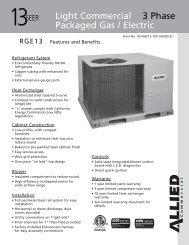K-Series (7.5-12.5 KGA) Installation Instructions - Allied Commercial
K-Series (7.5-12.5 KGA) Installation Instructions - Allied Commercial
K-Series (7.5-12.5 KGA) Installation Instructions - Allied Commercial
You also want an ePaper? Increase the reach of your titles
YUMPU automatically turns print PDFs into web optimized ePapers that Google loves.
<strong>KGA</strong>/KCA092, 102, 120, & 150 DIMENSIONS − Gas heat section shown6−1/8(156)5−5/8(143)BOTTOM SUPPLYAIR OPENING6−1/8(156)60−1/8 (1527)BASEBOTTOMPOWER ENTRY5−1/2 (140) Dia.27(686)24(610)10−3/4(273)BOTTOM RETURNAIR OPENING20(508)28(711)7 (178)6−5/8(168)7 (178)34−7/8(886)BOTTOMCONDENSATE101−1/4(2572)TOP VIEWBASE58−1/8(1476)OPTIONAL DISCONNECT(FACTORY INSTALLED)99−1/4(2521)43−3/8(1102)46−7/8(1191)1(25)CONDENSATEDRAIN (FRONT)5−3/8(137)GAS SUPPLYINLET18−1/2(470)FLUEOUTLET46−7/8(1191)60−1/8(1527)END VIEW3−1/2(89)ELECTRICINLETS34−7/8(886)39−7/8(1013)FORKLIFT SLOTS(BOTH SIDES)101−1/4(2572)SIDE VIEWLIFTING HOLES(FOR RIGGING)15−1/2(394)1−5/8(41)15−1/2(394)HORIZONTALSUPPLY AIROPENINGHORIZONTALRETURN AIROPENING30(762)12−1/8(308)6−1/8(156)31−1/2(800)66−3/8(1686)CONDENSATEDRAIN (BACK) 5−3/8(137)30(762)SIDE VIEW(Horizontal Openings)Page 2
If this unit has been used for heating or cooling ofbuildings or structures under construction, the followingconditions must be met or the warranty will be void: A room thermostat must control the unit. The use offixed jumpers that will provide continuous heating orcooling is not allowed. A pre−filter must be installed at the entry to the returnair duct. The return air duct must be provided and sealed tothe unit. Return air temperature range between 55°F (13°C)and 80°F (27°C) must be maintained. Air filters must be replaced and pre−filters must beremoved upon construction completion. The input rate and temperature rise must be set perthe unit rating plate. The heat exchanger, components, duct system, airfilters and evaporator coil must be thoroughlycleaned following final construction clean−up. The unit operating conditions (including airflow,cooling operation, ignition, input rate, temperaturerise and venting) must be verified according to theseinstallation instructions.Unit SupportIn downflow discharge installations, install the unit on anon−combustible surface only. Unit may be installed oncombustible surfaces when used in horizontal dischargeapplications or in downflow discharge applications wheninstalled on an C1CURB roof mounting frame.NOTE − Securely fasten roof frame to roof per local codes.A−Downflow Discharge ApplicationRoof Mounting with C1CURBMake sure the cap over the unit bottom drain hole issecure.1− The C1CURB roof mounting frame must be installed,flashed and sealed in accordance with theinstructions provided with the frame.2− The C1CURB roof mounting frame should be squareand level to 1/16" per linear foot (5mm per linearmeter) in any direction.3− Duct must be attached to the roof mounting frameand not to the unit; supply and return plenums mustbe installed before setting the unit.Installer’s Roof Mounting FrameMany types of roof frames can be used to install the unitdepending upon different roof structures. Items to keepin mind when using the building frame or supports are:1− The base is fully enclosed and insulated, so anenclosed frame is not required.2− The frames or supports must be constructed withnon−combustible materials and should be square andlevel to 1/16" per linear foot (5mm per linear meter)in any direction.3− Frame or supports must be high enough to preventany form of moisture from entering unit.Recommended minimum frame height is 14"(356mm).4− Duct must be attached to the roof mounting frameand not to the unit. Supply and return plenums mustbe installed before setting the unit.5− Units require support along all four sides of unit base.Supports must be constructed of steel or suitablytreated wood materials.NOTE−When installing a unit on a combustible surface fordownflow discharge applications, an C1CURB roofmounting frame is required.B−Horizontal Discharge Applications1− Units installed in horizontal airflow applications mustuse a horizontal conversion kit (K1HECK00).2− Specified installation clearances must be maintainedwhen installing units. Refer to figure 1.3− Top of support slab should be approximately 4"(102mm) above the finished grade and located so norun−off water from higher ground can collect aroundthe unit.4− Units require support along all four sides of unit base.Supports must be constructed of steel or suitablytreated wood materials.Duct ConnectionAll exterior ducts, joints and openings in roof or buildingwalls must be insulated and weather−proofed withflashing and sealing compounds in accordance withapplicable codes. Any duct passing through anunconditioned space must be insulated.CAUTIONIn downflow applications, do not drill or punchholes in base of unit. Leaking in roof may occur ifunit base is punctured.Rigging Unit For LiftingRig unit for lifting by attaching four cables to holes in unitbase rail. See figure 2.1− Detach wooden base protection before rigging.2− Connect rigging to the unit base using both holes ineach corner.3− All panels must be in place for rigging.Page 5
4− Place field-provided H-style pick in place just abovetop edge of unit. Frame must be of adequatestrength and length. (H−style pick prevents damageto unit.)<strong>KGA</strong>KCAUNIT*WEIGHTLBS.14011366KG.636620RIGGINGCAUTION − Do notwalk on unit.*Maximum weight with all available installedaccessories.LIFTING POINT SHOULDBE DIRECTLY ABOVECENTER OF GRAVITYCONDENSATE SIDE DRAIN CONNECTIONCAULK AROUND CONDENSATE COUPLINGNOTE − Allow clearance toopen doors when installingcondensate piping.Minimum Pitch1" (25 mm) per OPEN VENT10’ (3 m) of lineÁUNITMOUNTINGFRAMEÁIMPORTANT − ALLPANELS MUST BE INPLACE FOR RIGGING.ÁFIGURE 3ÁCONDENSATE BOTTOM DRAIN CONNECTIONUNITDRAIN PANCAULK AROUNDCONDENSATE COUPLINGOPEN VENTFIGURE 2Condensate DrainsMake drain connection to the 1" N.P.T. drain couplingprovided on unit.Note − The drain pan is made with a glass reinforcedengineered plastic capable of withstanding typical jointtorque but can be damaged with excessive force. Tightenpipe nipple hand tight and turn an additional quarter turn.A trap must be installed between drain connection and anopen vent for proper condensate removal. See figure 3 or4. It is sometimes acceptable to drain condensate ontothe roof or grade; however, a tee should be fitted to thetrap to direct condensate downward. The condensate linemust be vented. Check local codes concerningcondensate disposal. Refer to pages 2 and 3 forcondensate drain location.Units are shipped with the drain coupling facing the frontof the unit. Condensate can be drained from the back orbottom of the unit with the following modifications. Theunit can be installed in either downflow or horizontal airdischarge regardless of condensate drain location.Rear Drain Connection1− Remove heat access door. See figure 5.2− Remove filter access door.MOUNTINGFRAMEFILTERACCESS DOORMinimum Pitch1" (25 mm) per 10’(3 m) of lineFIGURE 4HEATACCESS DOORCONDENSATEDRAIN MULLIONFIGURE 53− Remove eight screws holding condensate drainmullion and remove mullion.Page 6
4− Lift front edge of the drain pan (to clear bottom drainplug) and slide drain pan out of unit. See figure 6.11− Use a field−provided 1" plug to seal side drainconnection.12− Replace the condensate drain mullion and reinstalleight screws.13− Reinstall access doors.BOTTOM CONDENSATE DRAINFIGURE 6DRAIN PANCAUTION: Be careful not todamage the coupling threadswhen drilling the hole.DRILL A PILOTHOLE IN CENTEROF COUPLING5− Make sure the cap over the unit bottom drain hole issecure.6− Rotate the drain pan until the downward slope istoward the back of the unit. Slide the drain pan backinto the unit. Be careful not to dislodge the cap overthe bottom drain hole.7− From the back side of the unit, pull the drain pancoupling through the rear condensate opening.8− Replace the condensate drain mullion and reinstalleight screws.9− Reinstall access doors.Bottom Drain Connection1− Remove heat access door. See figure 5.2− Remove filter access door.3− Remove eight screws holding condensate drainmullion and remove mullion.4− Lift front edge of the drain pan (to clear bottom drainplug) and slide drain pan out of unit. See figure 6.5− Turn the drain pan upside down and drill a pilot holethrough the bottom of the drain pan in the center of thecoupling. See figure 7.6− From the inside of the pan, use a Vari−Bit ® bit toenlarge the hole to 7/8". Do not damage couplingthreads.7− Remove the cap over the unit bottom drain hole.8− Slide the drain pan back into the unit.9− From the back side of the unit, pull the drain pancoupling through the rear condensate opening.10− From the front side of the unit, move the drain panuntil the bottom coupling settles into the unit bottomdrain opening. Once in place, check to make sure thecoupling is still positioned through the rearcondensate drain hole.Page 7After drilling the pilothole, drill a 7/8" hole fromthe inside of the pan.FIGURE 7Connect Gas Piping (Gas Units)Before connecting field−provided piping, check with gascompany or authorities having jurisdiction for local coderequirements. When installing gas supply piping, lengthof run from gas meter must be considered in determiningpipe size for 0.5" w.c. (.12kPa) maximum pressure drop.Do not use supply pipe smaller than unit gas connection.For natural gas units, operating pressure at the unit gasconnection must be a minimum of 4.7" w.c. (1.19kPa)and a maximum of 10.5" (2.60kPa) w.c. For LP/propanegas units, operating pressure at the unit gas connectionmust be a minimum of 11" w.c. (2.74kPa) and a maximumof 13.0" w.c. (3.23kPa).When making piping connections a drip leg should beinstalled on vertical pipe runs to serve as a trap forsediment or condensate. A 1/8" N.P.T. plugged tap islocated on gas valve for test gauge connection. Refer toHeating Start−Up section for tap location. Install a groundjoint union between the gas control manifold and the mainmanual shut−off valve. See figure 8 for gas supply pipingentering outside the unit. Figure 9 shows bottom gas entrypiping through the curb. Figure 10 shows bottom gasentry piping through the unit.Compounds used on threaded joints of gas piping shall beresistant to the action of liquified petroleum gases.
OUTSIDE OF UNIT GAS PIPE CONNECTIONGROUNDJOINT UNIONTO GASVALVEALL ELBOWS ARE 3/4"10" NIPPLEGROMMETBOTTOM GAS ENTRYTHROUGH THE UNITMULLION BETWEENHEAT AND COMPRES-SOR SECTIONSGROMMET7−1/2" NIPPLE5" NIPPLE4" NIPPLE4" NIPPLETO GASSUPPLY7"NIPPLETO GASSUPPLYTO GASVALVEGROUNDJOINT UNION4" NIPPLEGAS PIPINGSUPPORTMANUAL MAINSHUT−OFF VALVEDRIP LEG(REFER TOLOCAL CODES)ALTERNATEKNOCKOUTSROOF MOUNTINGFRAMEDRIP LEGMANUAL MAINSHUT−OFF VALVE3−1/2" NIPPLEFIGURE 83" NIPPLEFIGURE 10BOTTOM ENTRY GAS PIPINGTHROUGH THE CURBMULLION BETWEENHEAT AND COMPRES-SOR SECTIONS4" NIPPLETO GASVALVE4" NIPPLEPressure Test Gas Piping (Gas Units)When pressure testing gas lines, the gas valve mustbe disconnected and isolated. Gas valves can bedamaged if subjected to more than 0.5 psig (3.48kPa).See figure 11.GROMMETALL ELBOWS ARE 3/4"MANUAL MAINSHUT−OFF VALVETO GASSUPPLYROOFMOUNTINGFRAME10" NIPPLEFIGURE 95" NIPPLE7−1/2" NIPPLEGROUNDJOINT UNION4" NIPPLE3−1/2" NIPPLE3" NIPPLEDRIP LEGPage 8NOTE−Codes may require that manual main shut−offvalve and union (furnished by installer) be installed ingas line external to unit. Union must be of the groundjoint type.After all connections have been made, check all pipingconnections for gas leaks. Also check existing unit gasconnections up to the gas valve; loosening may occurduring installation. Use a leak detection solution or otherpreferred means. Do not use matches candles or othersources of ignition to check for gas leaks.CAUTIONSome soaps used for leak detection are corrosiveto certain metals. Carefully rinse piping thoroughlyafter leak test has been completed. Do not usematches, candles, flame or othe sources of ignitionto check for gas leaks.
WARNINGDanger of explosion. Can cause injuryor product or property damage. Do notuse matches, candles, flame or othersources of ignition to check for leaks.NOTE−In case emergency shut down is required, turn offthe main manual shut−off valve and disconnect mainpower to unit. These devices should be properly labeledby the installer.PRESSURE TEST GAS LINERefer to unit nameplate for minimum circuit ampacityand maximum fuse size.1− 230/460/575 volt units are factory wired. For 208Vsupply, disconnect the pink wire (230V) at all controlpower transformer(s). Reconnect the pink wire(208V). Tape the exposed end of the 230V pink wire.2− Route power through the bottom power entry areaand connect to L1, L2, and L3 on the bottom of TB2in control box for gas units or units equipped withelectric heat. Route power to F4 on cooling onlyunits (no electric heat). Route power to S48disconnect switch when the option isfactory−installed. See unit wiring diagram.3− Connect separate 120v wiring to optional GFCI outletpigtails.MANUAL MAINSHUT−OFF VALVEGAS VALVEFIGURE 11CAPA−Thermostat LocationCONTROL WIRINGRoom thermostat mounts vertically on a standard 2" X 4"handy box or on any non−conductive flat surface.Locate thermostat approximately 5 feet (1524mm)above the floor in an area with good air circulation ataverage temperature. Avoid locating the roomthermostat where it might be affected by:−drafts or dead spots behind doors and in corners−hot or cold air from ducts−radiant heat from sun or appliances−concealed pipes and chimneysHigh Altitude DerateLocate the high altitude conversion sticker in the unitliterature bag. Fill out the conversion sticker and affix nextto the unit nameplate.Refer to table 1 for high altitude adjustments.TABLE 1HIGH ALTITUDE DERATEAltitude Ft.*Gas Manifold Pressure2000−4500See Unit Nameplate4500 And Above Derate 2% / 1000 Ft. Above Sea Level*Units installed at 0−2000 feet do not need to be modified.NOTE - This is the only permissible derate for these units.Electrical ConnectionsPOWER SUPPLYDo not apply power or close disconnect switch untilinstallation is complete. Refer to start−up directions.Refer closely to unit wiring diagram.Page 9B−Control Wiring1− Route thermostat cable or wires from subbase tocontrol box (refer to unit dimensions to locate bottomand side power entry).IMPORTANT − Unless field thermostat wires are rated formaximum unit voltage, they must be routed away fromline voltage wiring. Use wire ties located near the lowerleft corner of the controls hat section to securethermostat cable.Use18 AWG wire for all applications using remotelyinstalled electro−mechanical and electronicthermostats.2− Install thermostat assembly in accordance withinstructions provided with thermostat.3− Connect thermostat wiring to TB1 terminal board onthe lower side of the controls hat section. Wire asshown in figure 12 for electro−mechanical andelectronic thermostats. If using other temperaturecontrol devices or energy management systems seeinstructions and wiring diagram provided bymanufacturer.
24 VOLT FIELD WIRING WITH ELECTRONIC ANDELECTRO−MECHANICAL THERMOSTATSTB11− Observe suction and discharge pressures andblower rotation on unit start−up.If pressure differential is not observed or blower rotation isnot correct:2− Suction pressure must drop, discharge pressuremust rise, and blower rotation must match rotationmarking.A2 THERMOSTATFIGURE 12NOT ALL TERMINALSARE FOUND ON ALLTHERMOSTATSNote − On electro−mechanical thermostatsset anticipator at 0.1 amps.Jumper terminals R andOC when thermostat hasno night setback terminalson units equipped with aneconomizer.IMPORTANT−Terminal connections at the wall plate orsubbase must be made securely. Loose control wireconnections may allow unit to operate but not with properresponse to room demand.Unit Power−UpA−General1− Make sure that unit is installed in accordance with theinstallation instructions and applicable codes.2− Inspect all electrical wiring, both field- andfactory-installed, for loose connections. Tighten asrequired.3− Check to ensure that refrigerant lines do not rubagainst the cabinet or against other refrigerant lines.4− Check voltage at main unit power connection.Voltage must be within range listed on nameplate. Ifnot, consult power company and have voltagecondition corrected before starting unit.5− Make sure filters are in place before start-up.6− Make sure there is no heating, cooling, or blowerdemand from thermostat. Apply power to unit.Blower Operation and AdjustmentsA−Three Phase Scroll Compressor Voltage PhasingThree phase scroll compressors must be phasedsequentially to ensure correct compressor and blowerrotation and operation. Compressor and blower arewired in phase at the factory. Power wires arecolor−coded as follows: line 1−red, line 2−yellow, line3−blue.Page 103− Disconnect all remote electrical power supplies.4− Reverse any two field−installed wires connected tothe line side of K3, TB2 or F4. Do not reverse wiresat blower contactor or compressors.5− Make sure the connections are tight.Discharge and suction pressures should operate attheir normal start-up ranges.MSAV TM Units − All MSAV units are equipped with a phasemonitor located in the control compartment. The phasemonitor will detect the phasing of incoming power. If theincoming power is out of phase or if any of the three phasesare lost, the indicating LED on the phase monitor will turnred and the unit will not start. In normal operation withcorrect incoming power phasing, the LED will be green.B−Blower OperationInitiate blower demand at thermostat according toinstructions provided with thermostat. Unit will cycle onthermostat demand. The following steps apply toapplications using a typical electro−mechanicalthermostat.1− Blower operation is manually set at the thermostatsubbase fan switch. With fan switch in ON position,blowers will operate continuously.2− With fan switch in AUTO position, the blowers willcycle with demand. Blowers and entire unit will be offwhen system switch is in OFF position.C−Blower AccessThe blower assembly is secured to a sliding frame whichallows the blower motor to be pulled out of the unit. Seefigure 13.1− Loosen the reusable wire tie which secures theblower wiring to the blower motor mounting plate.2− Remove and retain screws on either side of slidingframe. Pull frame toward outside of unit.3− Slide frame back into original position when finishedservicing. Reattach the blower wiring in the previouslocation on the blower motor base using the wire tie.4− Replace retained screws on either side of the slidingframe.
TO INCREASE BELT TENSION STANDARD BLOWER ASSEMBLY1− Loosen four bolts securing motor mounting baseto frame.2− Turn adjusting bolt to the right, or clockwise, tomove the motor away from the blower housing.IMPORTANT − Gap between end of frame and motormounting base should be equal at both ends, i.e. parallelalong gap.3− Tighten four bolts securing motor mounting baseto frame.4− Relieve tension on two adjusting bolts.MOTOR MOUNTINGBASEBELT ADJUSTING BOLTS− TURN CLOCKWISETO TIGHTEN BELTBLOWERHOUSINGSIDE VIEWMOTORALLENSCREWPULLEYGAP BETWEENEDGES SHOULD BEPARALLEL ON BOTHENDS BEFORETIGHTENING MOTORMOUNTING BASE INPLACEMOTORBLOWERFRAMEREMOVE TWO SCREWSTO COMPLETELY SLIDEBLOWER OUT OF UNITD−Determining Unit CFMIMPORTANT − MSAV TM units are factory−set to run theblower at full speed when there is a blower (G) demandwithout a heating or cooling demand. Use the followingprocedure to adjust motor pulley to deliver the full loadcooling or heating CFM. See MSAV TM Start−Up section toset blower CFM for all modes once the motor pulley is set.1− The following measurements must be made with adry indoor coil. Run blower without a cooling demand.Measure the indoor blower shaft RPM. Air filters mustbe in place when measurements are taken.2− With all access panels in place, measure staticpressure external to unit (from supply to return).Blower performance data is based on static pressurereadings taken in locations shown in figure 14.Note − Static pressure readings can vary if not takenwhere shown.3− Referring to page 13, 14, or 15, use static pressureand RPM readings to determine unit CFM. Use pages16 and 17 when installing units with any of theoptional accessories listed.LOOSEN BEFOREADJUSTING BELT TENSION(TWO EACH SIDE)REMOVE TWO SCREWS ON EACHSIDE TO SLIDE FRAME PARTIALLYOUT OF UNIT FOR SERVICE ACCESSFIGURE 13Page 114− The blower RPM can be adjusted at the motor pulley.Loosen Allen screw and turn adjustable pulleyclockwise to increase CFM. Turn counterclockwise todecrease CFM. See figure 13. Do not exceedminimum and maximum number of pulley turns asshown in table 2.TABLE 2MINIMUM AND MAXIMUM PULLEY ADJUSTMENTBeltMinimumTurns OpenMaximumTurns OpenA Section 0 5B Section 1* 6*No minimum number of turns open when B belt is used onpulleys 6" O.D. or larger.E−Blower Belt AdjustmentMaximum life and wear can be obtained from belts onlyif proper pulley alignment and belt tension aremaintained. Tension new belts after a 24−48 hourperiod of operation. This will allow belt to stretch andseat in the pulley grooves. Make sure blower and motorpulleys are aligned as shown in figure 15.1− Loosen four bolts securing motor base to mountingframe. See figure 13.
LOCATION OF STATIC PRESSURE READINGSINSTALLATIONS WITH DUCTWORKINSTALLATIONS WITH CEILING DIFFUSERSROOFTOP UNITROOFTOP UNITMAINDUCT RUNSUPPLYRE-TURNRETURN AIRREADING LOCATIONFIRST BRANCHOFF OF MAIN RUNSUPPLY AIRREADINGLOCATIONSUPPLY AIRREADINGLOCATIONSUPPLYRE-TURNDIFFUSERRETURN AIRREADINGLOCATION2− To increase belt tension −Turn both adjusting bolts to the right, or clockwise, tomove the motor outward and tighten the belt. Thisincreases the distance between the blower motor andthe blower housing.To loosen belt tension −Turn the adjusting bolts to the left, orcounterclockwise to loosen belt tension.IMPORTANT − Align top edges of blower motor base andmounting frame base parallel before tightening two boltson the other side of base. Motor shaft and blower shaftmust be parallel.3− Tighten two bolts on each side of the motor mountingbase. This secures the mounting base to the frame.PULLEY ALIGNMENTALIGNEDFIGURE 141− Measure span length X. See figure 16.2− Apply perpendicular force to center of span (X) withenough pressure to deflect belt 1/64" for every inchof span length or 1.5mm per 100mm of span length.Example: Deflection distance of a 40" span would be40/64" or 5/8".Example: Deflection distance of a 400mm spanwould be 6mm.3− Measure belt deflection force. For a new 2 and 3hpbelt, the deflection force should be 5.0−7.0 lbs.(35−48kPa). For a new 5hp belt, the deflection forceshould be 7−10lbs. (48−69kPa).A force below these values indicates anundertensioned belt. A force above these valuesindicates an overtensioned belt.MEASURE BELT TENSIONMOTORPULLEYBELTBLOWERPULLEYF−Check Belt TensionNOT ALIGNEDFIGURE 15Overtensioning belts shortens belt and bearing life.Check belt tension as follows:FORCEDEFLECTION 1/64" PER INCH OF SPANOR 1.5mm PER 100mm OF SPANFIGURE 16F−Field−Furnished Blower DrivesFor field−furnished blower drives, use pages 13 through17 to determine BHP and RPM required. Reference table3 for drive component manufacturer’s numbers.Page 12
BLOWER DATA092 AND 102 BELT DRIVE BLOWER − BASE UNITBLOWER TABLE INCLUDES RESISTANCE FOR BASE UNIT ONLY (NO HEAT SECTION) WITH DRY INDOOR COIL AND AIRFILTERS IN PLACE. FOR ALL UNITS ADD:1 − Wet indoor coil air resistance of selected unit.2 − Any factory installed options air resistance (heat section, economizer, etc.)3 − Any field installed accessories air resistance (duct resistance, diffuser, etc.)Then determine from blower table blower motor output required.See page 16 for blower motors and drives.See page 16 for wet coil and option/accessory air resistance data.MAXIMUM STATIC PRESSURE WITH GAS HEAT - 2.0 in. w.g.MINIMUM AIR VOLUME REQUIRED FOR USE WITH OPTIONAL ELECTRIC HEAT (Maximum Static Pressure - 2.0 in. w.g.)<strong>7.5</strong> kW, 15 kW, 22.5 kW, 30 kW and 45 kW - 2800 cfmTotalAirVolumecfmTotal Static Pressure − in. w.g.0.2 0.4 0.6 0.8 1.0 1.2 1.4 1.6 1.8 2 2.2 2.4 2.6RPM BHP RPM BHP RPM BHP RPM BHP RPM BHP RPM BHP RPM BHP RPM BHP RPM BHP RPM BHP RPM BHP RPM BHP RPM BHP1750 608 0.05 651 0.03 696 0.06 744 0.22 794 0.60 845 0.95 894 1.24 934 1.38 978 1.47 1047 1.66 1120 1.89 1179 2.15 1230 2.402000 615 0.07 657 0.05 702 0.10 748 0.36 797 0.72 846 1.05 892 1.30 933 1.45 977 1.55 1049 1.75 1124 2.00 1181 2.23 1234 2.472250 624 0.09 664 0.07 707 0.14 753 0.50 800 0.84 847 1.15 892 1.38 934 1.53 979 1.65 1051 1.86 1126 2.12 1183 2.36 1238 2.622500 632 0.11 672 0.09 714 0.29 758 0.64 803 0.97 849 1.26 893 1.48 936 1.63 983 1.75 1052 1.96 1124 2.22 1184 2.49 1241 2.772750 641 0.13 680 0.11 721 0.45 763 0.78 807 1.09 852 1.37 896 1.58 940 1.74 989 1.88 1053 2.08 1121 2.34 1185 2.63 1244 2.933000 651 0.15 689 0.29 728 0.61 770 0.93 812 1.23 856 1.49 901 1.70 947 1.87 996 2.02 1055 2.21 1120 2.47 1186 2.78 1248 3.103250 661 0.17 698 0.46 737 0.78 777 1.09 819 1.38 862 1.63 908 1.84 955 2.01 1004 2.17 1059 2.36 1122 2.62 1189 2.94 1252 3.283500 672 0.36 708 0.65 746 0.95 786 1.25 827 1.53 870 1.78 916 1.99 965 2.17 1013 2.33 1065 2.52 1126 2.79 1193 3.12 1257 3.473750 684 0.56 719 0.85 756 1.14 795 1.43 836 1.70 880 1.95 927 2.16 976 2.34 1023 2.51 1073 2.71 1133 2.98 1198 3.32 1263 3.674000 697 0.78 731 1.05 768 1.34 807 1.62 848 1.89 892 2.13 940 2.34 988 2.53 1034 2.71 1083 2.91 1141 3.19 1205 3.53 1270 3.894250 710 1.00 745 1.27 781 1.55 819 1.83 861 2.09 906 2.33 954 2.55 1001 2.74 1046 2.93 1094 3.14 1151 3.42 1214 3.76 1278 4.12Page 13
BLOWER DATA120 BELT DRIVE BLOWER − BASE UNITBLOWER TABLE INCLUDES RESISTANCE FOR BASE UNIT ONLY (NO HEAT SECTION) WITH DRY INDOOR COIL AND AIRFILTERS IN PLACE. FOR ALL UNITS ADD:1 − Wet indoor coil air resistance of selected unit.2 − Any factory installed options air resistance (heat section, economizer, etc.)3 − Any field installed accessories air resistance (duct resistance, diffuser, etc.)Then determine from blower table blower motor output required.See page 16 for blower motors and drives.See page 16 for wet coil and option/accessory air resistance data.MAXIMUM STATIC PRESSURE WITH GAS HEAT - 2.0 in. w.g.MINIMUM AIR VOLUME REQUIRED FOR USE WITH OPTIONAL ELECTRIC HEAT (Maximum Static Pressure - 2.0 in. w.g.)15 kW, 22.5 kW, 30 kW and 45 kW - 2800 cfm60 kW - 4000 cfmTotalAirVolumecfmTotal Static Pressure − in. w.g.0.2 0.4 0.6 0.8 1.0 1.2 1.4 1.6 1.8 2 2.2 2.4 2.6RPM BHP RPM BHP RPM BHP RPM BHP RPM BHP RPM BHP RPM BHP RPM BHP RPM BHP RPM BHP RPM BHP RPM BHP RPM BHP2000 593 0.11 636 0.07 682 0.10 731 0.22 784 0.60 840 0.96 898 1.26 948 1.38 996 1.47 1045 1.57 1092 1.71 1140 1.92 1188 2.322250 604 0.15 645 0.11 690 0.15 739 0.39 790 0.74 846 1.08 901 1.34 953 1.48 1002 1.57 1052 1.70 1100 1.86 1149 2.09 1197 2.422500 615 0.19 655 0.15 699 0.20 747 0.55 797 0.89 851 1.20 906 1.44 959 1.58 1009 1.68 1059 1.83 1108 2.01 1158 2.26 1206 2.522750 626 0.23 666 0.19 709 0.37 755 0.71 805 1.03 858 1.32 912 1.55 966 1.70 1017 1.81 1067 1.97 1117 2.17 1166 2.44 1215 2.713000 637 0.27 677 0.24 719 0.55 764 0.87 813 1.18 866 1.45 920 1.67 975 1.82 1026 1.96 1076 2.13 1126 2.35 1176 2.63 1225 2.923250 650 0.31 688 0.43 730 0.73 775 1.04 823 1.34 875 1.60 930 1.81 985 1.97 1036 2.12 1086 2.31 1136 2.54 1186 2.83 1235 3.133500 663 0.35 700 0.63 741 0.92 786 1.22 834 1.50 886 1.76 942 1.96 997 2.14 1048 2.31 1097 2.51 1147 2.75 1196 3.04 1245 3.353750 676 0.57 714 0.84 754 1.12 798 1.41 846 1.68 899 1.93 956 2.14 1010 2.32 1060 2.51 1109 2.72 1158 2.98 1207 3.27 1255 3.584000 691 0.79 728 1.05 768 1.33 812 1.61 860 1.88 914 2.12 971 2.34 1023 2.53 1072 2.73 1121 2.95 1169 3.22 1218 3.51 1266 3.834250 706 1.03 743 1.28 783 1.55 827 1.82 876 2.09 931 2.33 987 2.55 1037 2.76 1085 2.97 1133 3.20 1181 3.47 1229 3.76 1277 4.084500 722 1.27 759 1.52 799 1.78 844 2.05 894 2.31 949 2.56 1003 2.79 1052 3.00 1098 3.22 1145 3.46 1193 3.73 1241 4.03 1289 4.344750 739 1.53 776 1.77 817 2.03 862 2.30 913 2.56 968 2.81 1020 3.04 1066 3.27 1112 3.49 1158 3.74 1205 4.01 1253 4.30 1301 4.615000 757 1.79 794 2.04 835 2.30 882 2.56 934 2.83 988 3.08 1036 3.32 1081 3.55 1125 3.78 1171 4.02 1218 4.29 1265 4.59 1312 4.89Page 14
BLOWER DATA150 BELT DRIVE BLOWER − BASE UNITBLOWER TABLE INCLUDES RESISTANCE FOR BASE UNIT ONLY (NO HEAT SECTION) WITH DRY INDOOR COIL AND AIRFILTERS IN PLACE. FOR ALL UNITS ADD:1 − Wet indoor coil air resistance of selected unit.2 − Any factory installed options air resistance (heat section, economizer, etc.)3 − Any field installed accessories air resistance (duct resistance, diffuser, etc.)Then determine from blower table blower motor output required.See page 16 for blower motors and drives.See page 16 for wet coil and option/accessory air resistance data.MAXIMUM STATIC PRESSURE WITH GAS HEAT - 2.0 in. w.g.MINIMUM AIR VOLUME REQUIRED FOR USE WITH OPTIONAL ELECTRIC HEAT (Maximum Static Pressure - 2.0 in. w.g.)15 kW, 22.5 kW, 30 kW and 45 kW - 2800 cfm60 kW - 4000 cfmTotalAirVolumecfmTotal Static Pressure − in. w.g.0.2 0.4 0.6 0.8 1.0 1.2 1.4 1.6 1.8 2 2.2 2.4 2.6RPM BHP RPM BHP RPM BHP RPM BHP RPM BHP RPM BHP RPM BHP RPM BHP RPM BHP RPM BHP RPM BHP RPM BHP RPM BHP2500 527 0.44 589 0.62 654 0.78 723 0.91 789 1.05 850 1.21 904 1.39 955 1.58 1003 1.77 1052 1.96 1101 2.14 1152 2.33 1203 2.532750 545 0.55 606 0.72 672 0.88 740 1.03 804 1.17 861 1.34 914 1.53 962 1.72 1010 1.92 1057 2.10 1105 2.29 1154 2.47 1206 2.683000 564 0.66 626 0.84 692 1.01 759 1.16 819 1.32 874 1.49 924 1.68 971 1.88 1017 2.08 1063 2.26 1110 2.44 1158 2.63 1208 2.833250 585 0.79 648 0.98 714 1.14 778 1.31 836 1.48 887 1.66 935 1.86 981 2.06 1026 2.26 1071 2.45 1117 2.63 1163 2.80 1213 3.003500 607 0.93 672 1.13 737 1.31 798 1.48 852 1.66 901 1.85 948 2.05 993 2.26 1037 2.46 1081 2.65 1125 2.83 1171 3.01 1221 3.213750 632 1.10 698 1.31 762 1.50 819 1.67 869 1.86 915 2.05 961 2.25 1005 2.47 1049 2.68 1092 2.88 1136 3.05 1181 3.24 1231 3.454000 660 1.30 726 1.52 787 1.70 838 1.87 885 2.06 930 2.26 974 2.48 1018 2.71 1062 2.93 1105 3.12 1149 3.30 1194 3.49 1245 3.724250 691 1.53 755 1.75 810 1.91 857 2.07 901 2.27 945 2.50 990 2.74 1034 2.98 1077 3.20 1120 3.39 1163 3.58 1210 3.79 1262 4.034500 724 1.78 783 1.98 831 2.12 874 2.28 917 2.50 962 2.75 1006 3.02 1051 3.27 1094 3.49 1137 3.70 1181 3.89 1228 4.11 1281 4.384750 757 2.05 809 2.20 851 2.33 891 2.51 935 2.76 980 3.05 1025 3.33 1070 3.59 1113 3.82 1156 4.03 1201 4.24 1249 4.47 1303 4.755000 787 2.31 831 2.43 870 2.57 910 2.78 954 3.06 1000 3.38 1046 3.68 1091 3.95 1135 4.19 1178 4.40 1224 4.62 1272 4.86 1325 5.135250 814 2.55 852 2.66 889 2.83 930 3.09 975 3.41 1023 3.76 1070 4.08 1115 4.35 1159 4.59 1203 4.81 1248 5.03 1297 5.27 1350 5.535500 835 2.78 871 2.91 909 3.13 952 3.44 999 3.81 1049 4.18 1096 4.51 1142 4.79 1186 5.03 1229 5.24 1275 5.46 1324 5.69 - - - - - -5750 854 3.01 890 3.19 930 3.48 977 3.86 1027 4.27 1078 4.66 1126 4.99 1171 5.26 1214 5.49 1258 5.70 - - - - - - - - - - - - - - - - - -6000 871 3.26 910 3.53 955 3.90 1006 4.34 1060 4.80 1111 5.19 1158 5.51 - - - - - - - - - - - - - - - - - - - - - - - - - - - - - - - - - - - -6250 890 3.57 934 3.94 985 4.41 1041 4.91 1096 5.38 - - - - - - - - - - - - - - - - - - - - - - - - - - - - - - - - - - - - - - - - - - - - - - - -Page 15
BLOWER DATAFACTORY INSTALLED BELT DRIVE KIT SPECIFICATIONSNominalhpMaximumhpDrive Kit NumberRPM Range2 2.3 1 590 - 8902 2.3 2 800 - 11052 2.3 3 795 - 11953 3.45 4 730 - 9703 3.45 5 940 - 12003 3.45 6 1015 - 13005 5.75 10 900 - 11355 5.75 11 1040 - 13155 5.75 12 1125 - 1425POWER EXHAUST FAN PERFORMANCEReturn Air System Static PressureAir Volume Exhaustedin. w.g.cfm0 31750.05 29550.10 26850.15 24100.20 21650.25 19200.30 14200.35 1200FACTORY INS TALLED OPTIONS/FIELD INSTALLED ACCESSORY AIR RESISTANCE - in. w.g.AirVolumecfmWet Indoor Coil092, 102 120 150Gas Heat ExchangerStandardHeatMediumheatPage 16HighHeatElectricHeatEconomizerMERV8FiltersMERV13Return AirAdaptorPlate1750 0.06 0.08 0.09 0.06 0.02 0.02 0.03 0.05 0.01 0.03 0.002000 0.07 0.10 0.11 0.07 0.05 0.06 0.03 0.06 0.01 0.03 0.002250 0.07 0.10 0.13 0.07 0.07 0.08 0.04 0.08 0.01 0.04 0.002500 0.09 0.12 0.15 0.09 0.10 0.11 0.04 0.11 0.01 0.05 0.002750 0.09 0.12 0.17 0.09 0.11 0.12 0.05 0.12 0.02 0.05 0.003000 0.11 0.15 0.19 0.11 0.12 0.13 0.06 0.13 0.02 0.06 0.023250 0.13 0.18 0.23 0.12 0.15 0.16 0.06 0.15 0.02 0.06 0.023500 0.14 0.21 0.26 0.12 0.16 0.17 0.09 0.15 0.03 0.07 0.043750 0.16 0.23 0.29 0.14 0.19 0.20 0.09 0.15 0.03 0.08 0.074000 0.17 0.25 0.31 0.14 0.21 0.22 0.09 0.19 0.04 0.08 0.094250 0.20 0.27 0.34 0.14 0.24 0.28 0.13 0.19 0.04 0.09 0.114500 0.21 0.30 0.37 0.15 0.26 0.32 0.14 0.22 0.04 0.09 0.124750 0.23 0.32 0.40 0.16 0.29 0.37 0.17 0.25 0.05 0.10 0.165000 0.26 0.35 0.43 0.16 0.34 0.43 0.20 0.29 0.06 0.10 0.185250 0.27 0.36 0.46 0.16 0.37 0.47 0.22 0.32 0.06 0.11 0.195500 0.29 0.40 0.50 0.18 0.44 0.54 0.25 0.34 0.07 0.12 0.225750 0.32 0.43 0.56 0.19 0.49 0.59 0.31 0.45 0.07 0.12 0.256000 0.33 0.46 0.59 0.20 0.54 0.64 0.33 0.52 0.08 0.13 0.27
DRIVENO.TABLE 3MANUFACTURER’S NUMBERSDRIVE COMPONENTSADJUSTABLE SHEAVE FIXED SHEAVE BELTBROWNING NO. OEM PART NO. BROWNING NO. OEM PART NO. BROWNING NO. OEM PART NO.1 1VP34x7/8 31K6901 AK61x1 100244−20 AX54 100245−252 1VP40x7/8 79J0301 AK59x1 31K6801 AX55 100245−263 1VP34x7/8 31K6901 AK46x1 100244−17 AX52 100245−334 1VP44x7/8 53J9601 AK74x1 100244−21 AX58 100245−345 1VP50x7/8 98J0001 AK69x1 37L4701 AX58 100245−346 1VP50x7/8 98J0001 AK64x1 12L2501 AX57 100245−2810 1VP50x1−1/8 P−8−1977 BK77x1 49K4001 BX59 59A500111 1VP50x1−1/8 P−8−1977 BK67x1 100244−24 BX57 78L530112 1VP50x1−1/8 P−8−1977 BK62x1 100244−23 BX56 100245−11Cooling Start−UpA−OperationMSAV TM Units − Refer to the MSAV TM Start−Up section.1− Initiate first and second stage cooling demandsaccording to instructions provided with thermostat.2− No Economizer Installed in Unit −A first−stage cooling demand (Y1) will energizecompressor 1 and both condenser fans. Anincreased cooling demand (Y2) will energizecompressor 2.EVAPORATORCOIL STAGE 2REFRIGERANT STAGES(BOTH FANS ARE ENERGIZEDWITH A Y1 DEMAND)Units Equipped With Economizer −When outdoor air is acceptable, a first−stagecooling demand (Y1) will energize the economizer.An increased cooling demand (Y2) will energizecompressor 1 and both condenser fans. Whenoutdoor air is not acceptable unit will operate asthough no economizer is installed.3− Units contain two refrigerant circuits or stages. Seefigure 17.4− Each refrigerant circuit is separately charged withR−410A refrigerant. See unit rating plate for correctamount of charge.5− Refer to Cooling Operation and Adjustment section forproper method to check refrigerant charge.B−Refrigerant Charge and CheckWARNING−Do not exceed nameplate charge underany condition.This unit is factory charged and should require no furtheradjustment. If the system requires additional refrigerant,reclaim the charge, evacuate the system, and addrequired nameplate charge.NOTE − System charging is not recommended below60°F (15°C). In temperatures below 60°F (15°C) , thecharge must be weighed into the system.If weighing facilities are not available, or to check thecharge, use the following procedure:Page 1721FIGURE 17EVAPORATORCOIL STAGE 11− Attach gauge manifolds and operate unit in coolingmode with economizer disabled until systemstabilizes (approximately five minutes). Make sureoutdoor air dampers are closed.2− Check each stage separately with all stages operating.3− Use a thermometer to accurately measure theoutdoor ambient temperature.4− Apply the outdoor temperature to tables 4 through 7to determine normal operating pressures. Pressuresare listed for sea level applications at 80°F dry bulb and67°F wet bulb return air.5− Compare the normal operating pressures to thepressures obtained from the gauges. Minor variations inthese pressures may be expected due to differences ininstallations. Significant differences could mean that thesystem is not properly charged or that a problem existswith some component in the system. Correct anysystem problems before proceeding.
6− If discharge pressure is high, remove refrigerant fromthe system. If discharge pressure is low, addrefrigerant to the system. Add or remove charge in increments. Allow the system to stabilize each timerefrigerant is added or removed.7− Use the following approach method along with thenormal operating pressures to confirm readings.TABLE 4<strong>KGA</strong>/KCA092S NORMAL OPERATING PRESSURESOutdoorCoilEnteringAir TempDischarge+10 psigCIRCUIT 1 CIRCUIT 2DischargeSuction+5 psig +10 psigSuction+5 psig65 F 260 130 269 13275 F 301 133 311 13385 F 343 135 354 13695 F 388 138 401 139105 F 435 140 449 141115 F 481 142 497 144TABLE 5KCA/<strong>KGA</strong>102S NORMAL OPERATING PRESSURESOutdoorCoilEnteringAir TempDischarge+10 psigCIRCUIT 1 CIRCUIT 2DischargeSuction+5 psig +10 psigSuction+5 psig65 F 262 128 270 12975 F 299 131 310 13185 F 342 134 353 13495 F 386 137 399 136105 F 434 140 448 139115 F 487 143 501 142TABLE 6KCA/<strong>KGA</strong>120S NORMAL OPERATING PRESSURESOutdoorCoilEnteringAir TempDischarge+10 psigCIRCUIT 1 CIRCUIT 2DischargeSuction+5 psig +10 psigSuction+5 psig65 F 275 135 282 13675 F 313 137 323 13885 F 355 140 366 14195 F 400 142 414 143105 F 447 145 464 145115 F 499 148 517 148TABLE 7KCA/<strong>KGA</strong>150S NORMAL OPERATING PRESSURESOutdoorCoilEnteringAir TempDischarge+10 psigCIRCUIT 1 CIRCUIT 2DischargeSuction+5 psig +10 psigSuction+5 psig65 F 279 132 283 13675 F 318 134 323 13885 F 360 136 364 13995 F 406 138 411 140105 F 456 141 462 142115 F 508 145 515 145Page 18D−Charge Verification − Approach Method−AHRI Testing1− Using the same thermometer, compare liquidtemperature (at condenser outlet) to outdoor ambienttemperature.Approach Temperature = Liquid temperature minusambient temperature.2− Approach temperature should match values shown intable 8. An approach temperature greater than thisvalue indicates an undercharge. An approachtemperature less than this value indicates anovercharge.TABLE 8APPROACH TEMPERATURELiquid Temp. Minus Ambient Temp.Unit1st Stage2nd Stage092 9°F + 1 (5.0°C + 0.5) 8°F + 1 (4.4°C + 0.5)102 7°F + 1 (3.9°C + 0.5) 6°F + 1 (3.3°C + 0.5)120 8°F + 1 (4.4°C + 0.5) 6°F + 1 (3.3°C + 0.5)150 6°F + 1 (3.3°C + 0.5) 6°F + 1 (3.3°C + 0.5)3− The approach method is not valid for grossly over orundercharged systems. Use tables 4 through 7 as aguide for typical operating pressures.C−Compressor ControlsSee unit wiring diagram to determine which controls areused on each unit. Optional controls are identified onwiring diagrams by arrows at junction points.1− Freezestats (S49, S50)Switches de−energize compressors when evaporatorcoil temperature falls below 29°F (−2°C) to preventevaporator freeze−up. Switches reset whenevaporator coil temperature reaches 58°F (15°C).Gas Heat Start−Up (Gas Units)FOR YOUR SAFETY READ BEFORE LIGHTINGWARNINGElectric shock hazard. Can cause injuryor death. Do not use this unit if any parthas been under water. Immediately calla qualified service technician to inspectthe unit and to replace any part of thecontrol system and any gas controlwhich has been under water.WARNINGDanger of explosion. Can cause injuryor product or property damage. If overheatingoccurs or if gas supply fails toshut off, shut off the manual gas valveto the appliance before shutting offelectrical supply.
WARNINGElectric shock hazard. Can causeinjury or death. Before attempting toperform any service or maintenance,turn the electrical power to unit OFF atdisconnect switch(es). Unit may havemultiple power supplies.WARNINGSMOKE POTENTIALThe heat exchanger in this unit could be a source ofsmoke on initial firing. Take precautions with respectto building occupants and property. Vent initialsupply air outside when possible.BEFORE LIGHTING smell all around the appliance areafor gas. Be sure to smell next to the floor because somegas is heavier than air and will settle on the floor.Use only your hand to push in or turn the gas control knob.Never use tools. If the knob will not push in or turn byhand, do not try to repair it, call a qualified servicetechnician. Force or attempted repair may result in a fireor explosion.WARNINGDanger of explosion. Can cause injury ordeath. Do not attempt to light manually.Unit has a direct spark ignition system.This unit is equipped with an automatic spark ignitionsystem. There is no pilot. In case of a safety shutdown,move thermostat switch to OFF and return the thermostatswitch to HEAT to reset ignition control.A−Placing Unit In OperationWARNINGDanger of explosion and fire. Can causeinjury or product or property damage.You must follow these instructionsexactly.Gas Valve Operation for HoneywellVR8205Q/VR8305Q (figure 18)HONEYWELL VR8205Q/VR8305Q SERIES GAS VALVEHIGH FIREADJUSTMENTINLETPRESSURETAPLOW FIREADJUSTMENTGas valve knob is shown in OFF position.MANIFOLDPRESSURETAPFIGURE 185− Turn the knob on the gas valve clockwise toOFF". Do not force.6− Turn the knob on the gas valve counterclockwiseto ON". Do not force.7− Close or replace the heat section access panel.8− Turn on all electrical power to appliance.9− Set thermostat to desired setting.10− The ignition sequence will start.11− If the appliance does not light the first time (gas linenot fully purged), it will attempt up to two moreignitions before locking out.12− If lockout occurs, repeat steps 1 through 10.13− If the appliance will not operate, follow theinstructions Turning Off Gas to Appliance" and callyour service technician or gas supplier.Turning Off Gas to Unit1− If using an electromechanical thermostat, set to thelowest setting.2− Before performing any service, turn off all electricalpower to the appliance.3− Open or remove the heat section access panel.4− Turn the knob on the gas valve clockwise toOFF". Do not force.5− Close or replace the heat section access panel.WARNINGDanger of explosion. Can cause injury ordeath. Do not attempt to light manually.Unit has a direct spark ignition system.1− Set thermostat to lowest setting.2− Turn off all electrical power to appliance.Heating Operation and Adjustments3− This appliance is equipped with an ignition device (Gas Units)which automatically lights the burner. Do not try to A−Heating Sequence of Operationlight the burner by hand.1− On a heating demand the combustion air inducer4− Open or remove the heat section access panel.starts immediately.Page 19
2− Combustion air pressure switch proves inducer MSAV TM Start−Upoperation. After a 30−second pre−purge, power isallowed to ignition control. Switch is factory set andA−Generalrequires no adjustment.Optional Multi−Stage Air Volume (MSAV TM ) units are3− Spark ignitor energizes and gas valve solenoid opens.available which provide two blower speeds. The blowerwill operate at lower speeds when cooling demand is low4− Spark ignites gas, ignition sensor proves the flameand higher speeds when cooling demand is high. Thisand combustion continues.results in lower energy consumption.5− If flame is not detected after first ignition trial, ignition MSAV TM units will operate at high speed duringcontrol will repeat steps 3 and 4 two more times ventilation (blower G" only signal) but can be adjusted tobefore locking out the gas valve.operate at low speed.6− For troubleshooting purposes, an ignition attempt Low speed is approximately 2/3 of the full speed RPM.after lock out may be re−established manually. MoveB−Set Maximum Blower CFMthermostat to OFF" and return thermostat switch toHEAT" position.1− Initiate a blower (G) only signal from the roomthermostat or control system.B−Ignition Control Diagnostic LED’s2− Adjust the blower pulley to deliver the full (highTABLE 9speed) CFM in the typical manner. See DeterminingIGNITION CONTROL HEARTBEAT LED STATUSUnit CFM in the Blower Operation and AdjustmentLEDIndicatessection.FlashesC−Set Blower Speed During VentilationSlow Normal operation. No call for heat.To save energy during ventilation, the blower speed canFast Normal operation. Call for heat.be set to low. This is accomplished by changing theSteady OffInternal control fault OR no power toventilation speed switch on the VFD control board to LO".control OR Gas Valve Relay Fault.See figure 19.Steady On Control internal failure.Note − On units equipped with an economizer, set damperminimum position as shown in the next section. After2 Lockout. Failed to detect or sustain flame.adjusting the low speed minimum position, the ventilationProve switch open or closed or rollout3speed switch will be in the LO" position.switch open.D−Set Damper Minimum Position (Units W/ Economizer)Limit switch is open and/or limit has4opened three times.To maintain required minimum ventilation air volumes5when the unit is in the occupied mode, two minimumFlame sensed but gas valve solenoidnot energized.damper positions must be set. A high and a low speedC−Limit Controlspotentiometer are provided on the VFD control board toadjust minimum damper position. See figure 19.Limit controls are factory−set and are not adjustable. TheSet High Speed Minimum Positionprimary limit is located on the blower deck to the right of1− Initiate a blower (G) only AND occupied demand fromblower assembly.the room thermostat or control system.D−Heating AdjustmentMain burners are factory−set and do not requireadjustment.The following manifold pressures are listed on the gas valve.Natural Gas Units − Low Fire − 1.6" w.c. (not adjustable)Natural Gas Units − High Fire − 3.7" w.c.LP Gas Units − Low Fire − 5.5" w.c. (not adjustable)LP Gas Units − High Fire − 10.5" w.c.2− Set the ventilation speed switch on the VFD controlboard to HI".3− Rotate the high speed potentiometer on the VFDcontrol board to set the high speed minimum damperposition.4− Measure the intake air CFM. If the CFM is lower thanthe design specified CFM for ventilation air, use thepotentiometer to increase the damper percent open.If the CFM is higher than specified, decrease theElectric Heat Start−Up (KCA Units)damper percent open.Optional electric heat will stage on and cycle withthermostat demand. Number of stages of electric heat willvary depending on electric heat assembly. See electricheat wiring diagram on unit for sequence of operation.Note − Intake air CFM can also be determined using theoutdoor air temperature, return air temperature andmixed air temperature. Refer to the economizer oroutdoor air damper installation instructions.Page 20
Set Low Speed Minimum Position1− Initiate a blower (G) only AND occupied demand fromthe room thermostat or control system.2− Set the ventilation speed switch on the VFD controlboard to LO".3− Rotate the low speed potentiometer on the VFDcontrol board to set the low speed minimum damperposition.4− Measure the intake air CFM. If the CFM is lower thanthe design specified CFM for ventilation air, use thepotentiometer to increase the damper percent open.If the CFM is higher than specified, decrease thedamper percent open.Note − Intake air CFM can also be determined using theoutdoor air temperature, return air temperature andmixed air temperature. Refer to the economizer oroutdoor air damper installation instructions.LVC2 (A183) VFD CONTROL BOARDVENTILATIONSPEED SWITCHPOWERLEDLOW SPEEDMINIMUM POSITIONPOTENTIOMETERHIGH SPEEDMINIMUM POSITIONPOTENTIOMETERFIGURE 19Troubleshoot LVC2 Board (A183)Refer to wiring diagram sections B (unit), C (control) andD (economizer) located on inside of unit panels.1− Inspect the LVC2 for damaged components. Replacethe LVC2 if damaged components are found.2− Check all wire connections to LVC2; secure if loose.3− Check for 24VAC signal at the thermostat blowerinput (G to GND terminal). See figure 20.LVC2 BOARD TERMINAL DESIGNATIONS24VDCVFD INPUTS;H2 HEADERFIGURE 2024VACTHERMOSTAT INPUTS;H1 HEADER4− If there is no thermostat signal, troubleshoot backtoward the thermostat.5− Check the power LED on the board. See figure 19.6− If the power LED is not on, check voltage betweenLVC2 terminals PC (H2−1) and SD (H2−5). Voltageshould read 24VDC.7− If voltage does not read 24VDC, disconnect the H2header from the LVC2 VFD inputs terminal block (tomake sure the LVC2 is not shorting 24VDC supplyfrom the inverter). Measure the voltage between theend terminals on the H2 header. If 24VDC is present,replace the LVC2 board. If no voltage is read,troubleshoot the VFD.8− When LVC2 24VAC thermostat blower (G) input and24VDC power are present, check the LVC2 low andhigh speed outputs. The LVC2 uses inverse logic toenable the blower; 1VDC will be read at the enabledblower speed terminal. See table 10.9− If all inputs are correct and the unit still does notoperate as intended, replace LVC2 board.TABLE 10LVC2 BOARD BLOWER OUTPUTSOutputTerminalsRL−SDRH−SDRL−SDRH−SDRL−SDRH−SDRL−SDRH−SDVoltage1VDC24VDC24VDC1VDC1VDC1VDC24VDC24VDCBlower OperationLow SpeedHigh SpeedIllegal State(replace board)Blower Off(replace board)Page 21
ServiceThe unit should be inspected once a year by a qualifiedservice technician.CAUTIONLabel all wires prior to disconnection when servicingcontrols. Wiring errors can cause improper anddangerous operation. Verify proper operation afterservicing.WARNINGProduct contains fiberglass wool.Disturbing the insulation in this product duringinstallation, maintenance, or repair will expose youto fiberglass wool. Breathing this may cause lungcancer. (Fiberglass wool is known to the State ofCalifornia to cause cancer.)Fiberglass wool may also cause respiratory, skin,and eye irritation.To reduce exposure to this substance or for furtherinformation, consult material safety data sheetsavailable from address shown on unit nameplate orcontact your supervisor.A−FiltersUnits are equipped with four 20 X 25 X 2" filters. Filtersshould be checked monthly and replaced whennecessary with filters of like kind and size. Take note ofair flow direction marking on filter frame whenreinstalling filters. See figure 21.NOTE−Filters must be U.L.C. certified or equivalent foruse in Canada.REMOVE FILTERSB−CompressorIf Interlink compressor replacement is necessary, call1−800−4−LENNOX (1−800−453−6669).IMPORTANTSome scroll compressors have an internal vacuumprotector that will unload scrolls when suctionpressure goes below 20 psig. A hissingsound will be heard when the compressor is runningunloaded. Protector will reset when lowpressure in system rises above 40 psig. DO NOTREPLACE COMPRESSOR.C−LubricationAll motors are lubricated at the factory. No furtherlubrication is required.D−Burners (Gas Units)Periodically examine burner flames for properappearance during the heating season. Before eachheating season examine the burners for any deposits orblockage which may have occurred.Clean burners as follows:1− Turn off both electrical power and gas supply to unit.2− Remove burner compartment access panel.3− Remove two screws securing burners to burnersupport and lift the burners from the orifices. Seefigure 22. Clean as necessary.4− Locate the ignitor under the left burners. Checkignitor spark gap with appropriately sized twist drillsor feeler gauges. See figure 23.GASVALVEBURNER BOX ASSEMBLYPULL TOREMOVEFILTERSBURNERSGAS MANIFOLDFIGURE 21Page 22FIGURE 22FLAMESENSOR
IGNITORSPARK GAPSHOULD BE 1/8"(3mm)DimensionUnitBtuh InputTABLE 11Length − in. (mm)Ignitor SensorA 130K 7−3/4 (197) 11 (279)B 180K 5 (127) 5−1/2 (140)C 240K 2−1/4 (57) 2−3/4 (70)7− Replace access panel.8− Restore electrical power and gas supply. Followlighting instructions attached to unit and useinspection port in access panel to check flame.FIGURE 235− Check the alignment of the ignitor and the sensor asshown in figure 24 and table 11.6− Replace burners and screws securing burner.WARNINGDanger of explosion. Can cause injury ordeath. Do not overtighten main burnermounting screws. Snug tighten only.E−Combustion Air Inducer (Gas Units)A combustion air proving switch checks combustion airinducer operation before allowing power to the gascontroller. Gas controller will not operate if inducer isobstructed.Under normal operating conditions, the combustion airinducer wheel should be checked and cleaned prior to theheating season. However, it should be examinedperiodically during the heating season to establish anideal cleaning schedule. With power supplydisconnected, the condition of the inducer wheel can bedetermined by looking through the vent opening.IGNITORIGNITOR AND SENSOR POSITIONSENSORAACBTOP VIEWBCSIDE VIEW IGNITORSIDE VIEW SENSORGas FlowGas Flow1−3/8"(35mm)1−3/4"(45mm)13/16"(21mm)BURNER BOXFIGURE 24Page 233/8"(10mm)
Clean combustion air inducer as follows:1− Shut off power supply and gas to unit.2− Disconnect pressure switch air tubing fromcombustion air inducer port.3− Remove and retain screws securing combustionair inducer to flue box. Remove vent connector.See figure 25.COMBUSTIONAIR INDUCERHEAT EXCHANGER ASSEMBLYHEATEXCHANGERTUBE6− Clean combustion air inlet louvers on heat accesspanel using a small brush.F−Flue Passageway and Flue Box (Gas Units)1− Remove combustion air inducer assembly asdescribed in section D.2− Remove flue box cover. Clean with a wire brush asrequired.3− Clean tubes with a wire brush.4− Reassemble the unit. The flue box cover gasket andcombustion air inducer gasket should also bereplaced during reassembly.G−Evaporator CoilInspect and clean coil at beginning of each cooling season.Clean using mild detergent or commercial coil cleaner.Flush coil and condensate drain with water taking care notto get insulation, filters and return air ducts wet.H−Condenser CoilGAS VALVEBURNERFIGURE 25VENTCONNECTOR4− Clean inducer wheel blades with a small brush andwipe off any dust from housing. Clean accumulateddust from front of flue box cover.5− Return combustion air inducer motor and ventconnector to original location and secure withretained screws. It is recommended that thecombustion air inducer gasket be replaced duringreassembly.Clean condenser coil annually with detergent orcommercial coil cleaner and inspect monthly during thecooling season.Condenser coils are made of single, two, and threeformed slabs. Dirt and debris may become trappedbetween the slabs. To clean between slabs, carefullyseparate coil slabs and wash them thoroughly. See figure26. Flush coils with water following cleaning.Note − Remove all screws and gaskets prior to cleaningprocedure and replace upon completion.J−Supply Air Blower WheelAnnually inspect supply air blower wheel for accumulateddirt or dust. Turn off power before attempting to removeaccess panel or to clean blower wheel.CLEAN CONDENSER COIL (092−120 SHOWN)TOP VIEWBLOWERENDPLATE IS SECUREDTO MULLIONCONDENSERCOILS1− Remove unit top panel and condenser section accesspanel.2− Remove screws securing coil end plate to mullion.3− Remove clips connecting coils slabs and separateslabs 3−4" (76−102mm).4− Clean coils with detergent or commercial coil cleaner.5− Rinse thoroughly with water and reassemble.CONDENSER ACCESS PANELFIGURE 26Page 24


